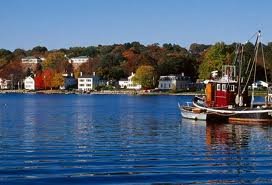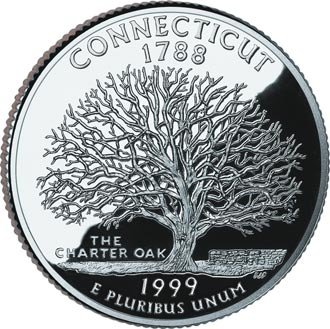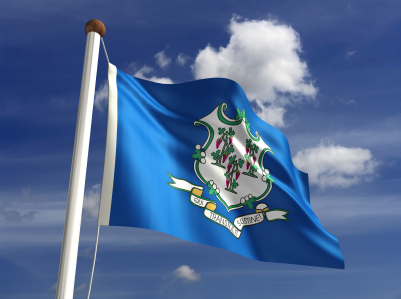US State of Connecticut
Connecticut is the southernmost state in the northeastern region of the United States known as New England. It is bordered by Rhode Island to the east, Massachusetts to the north, New York to the west, and Long Island Sound to the south. Its capital city is Hartford. The state is named after the Connecticut River, a major U.S. river that approximately bisects the state. The word is a French corruption of the Algonquian word quinetucket, which means "long tidal river".
Connecticut is the 3rd least extensive, 29th most populous and 4th most densely populated of the 50 United States. Called the Constitution State, Nutmeg State, and "The Land of Steady Habits", it was influential in the development of the federal government of the United States. Much of southern and western Connecticut (along with the majority of the state's population) is part of the New York metropolitan area: three of Connecticut's eight counties are statistically included in the New York City combined statistical area, which is widely referred to as the Tri-State area. Connecticut's center of population is in Cheshire, New Haven County, which is also located within the Tri-State area.
Connecticut's first European settlers were Dutch. They established a small, short-lived settlement in present-day Hartford at the confluence of the Park and Connecticut rivers, called Huys de Goede Hoop. Initially, half of Connecticut was a part of the Dutch colony, New Netherland, which included much of the land between the Connecticut and Delaware rivers. The first major settlements were established in the 1630s by England. Thomas Hooker led a band of followers overland from the Massachusetts Bay Colony and founded what would become the Connecticut Colony; other settlers from Massachusetts founded the Saybrook Colony and the New Haven Colony. The Connecticut and New Haven Colonies established documents of Fundamental Orders, considered the first constitutions in North America. In 1662, the three colonies were merged under a royal charter, making Connecticut a crown colony. This colony was one of the Thirteen Colonies that revolted against British rule in the American Revolution.
The Connecticut River, Thames River, and ports along Long Island Sound have given Connecticut a strong maritime tradition, which continues today. The state also has a long history of hosting the financial-services industry, including insurance companies in Hartford and hedge funds in Fairfield County. As of the 2010 Census, Connecticut features the highest per-capita income, Human Development Index (0.962), and median household income in the United States. Although it is a wealthy state by most measures, the income gap between its urban and suburban areas is unusually wide.
Interior portions of Connecticut have a humid continental climate, while the Connecticut shoreline (the state's southern four counties) has a borderline humid subtropical climate (sometimes statistically meeting this climate's criteria, sometimes not) with seasonal extremes tempered by proximity to the Atlantic Ocean. The city of Bridgeport (on Long Island Sound), like most other areas in metropolitan New York, typically falls within the humid subtropical climate zone under the Köppen Climate Classification system. Hartford (35 miles inland) has a humid continental climate. Consistent with its coastal reputation, Connecticut is a moderately sunny state, averaging between 2,400 and 2,800 hours of sunshine annually.
Summer is hot and humid throughout the state, with average highs in New London of 81 °F (27 °C) and 87 °F (31 °C) in Windsor Locks. Although summers are quite sunny in Connecticut, summer thunderstorms often bring quick downpours and thunder and lighting. Winters are generally cool to cold from south to north in Connecticut, with average temperatures ranging from 38 °F (3 °C) in the maritime influenced southeast to 29 °F (−2 °C) in the northwest in January. The average yearly snowfall ranges from about 50–60" in the higher elevations of the northern portion of the state to only 20-25" along the southeast coast of Connecticut. Early Spring (April) is coolish and mid and late Spring (May/early June) is warm to hot. Fall months are mild and bring colorful foliage across northern parts of the state (the southern and coastal areas have more oak and hickory trees and fewer maples) in October and November. During hurricane season, tropical cyclones occasionally affect the region. Thunderstorms are most frequent during the summer, occurring on average 30 times annually.
From Wikipedia, the free encyclopedia


Education Institutes in Connecticut
Hamden Hall Country Day School, Hamden, Connecticut
The Gilbert School, Winsted, Connecticut



